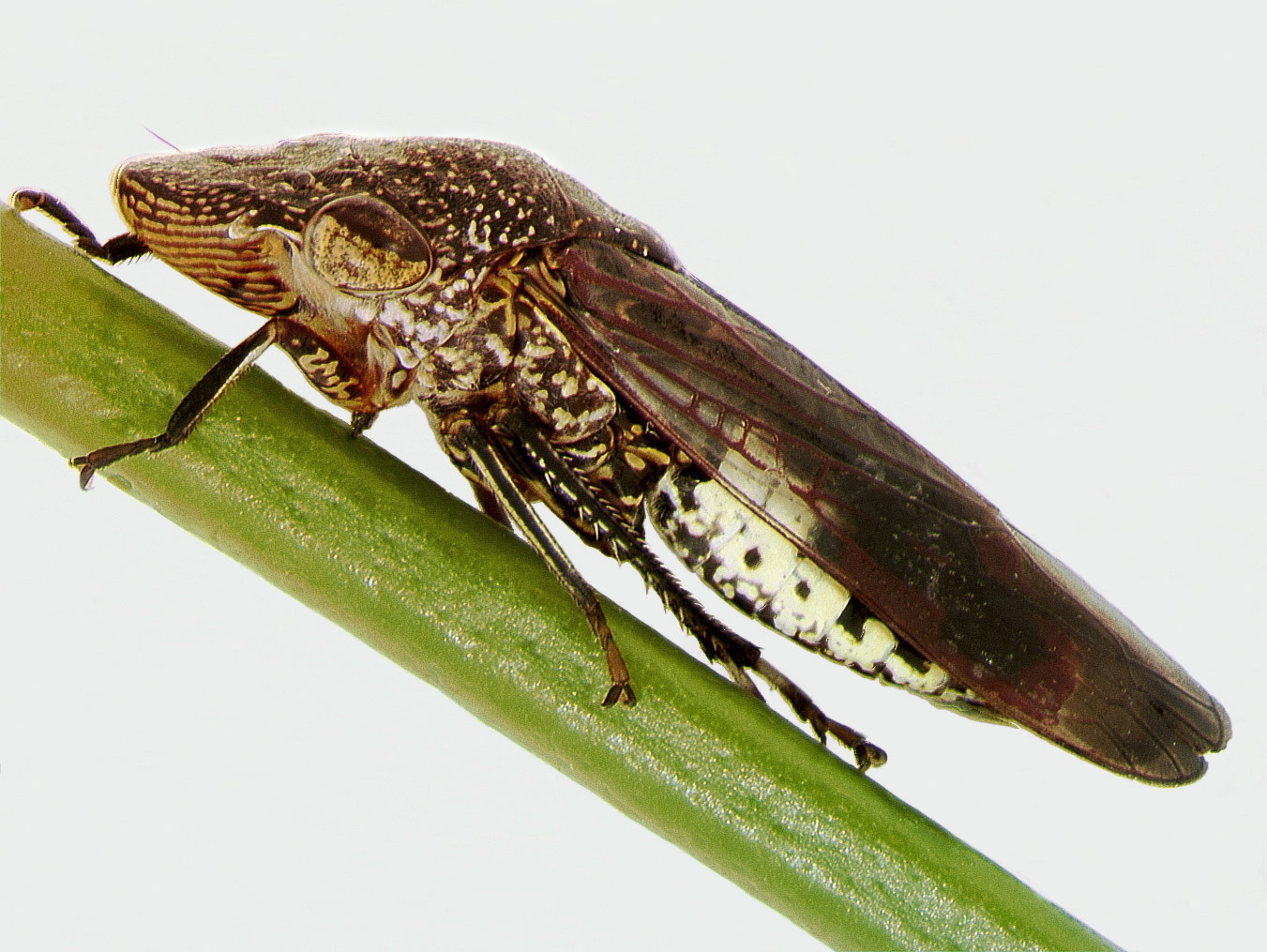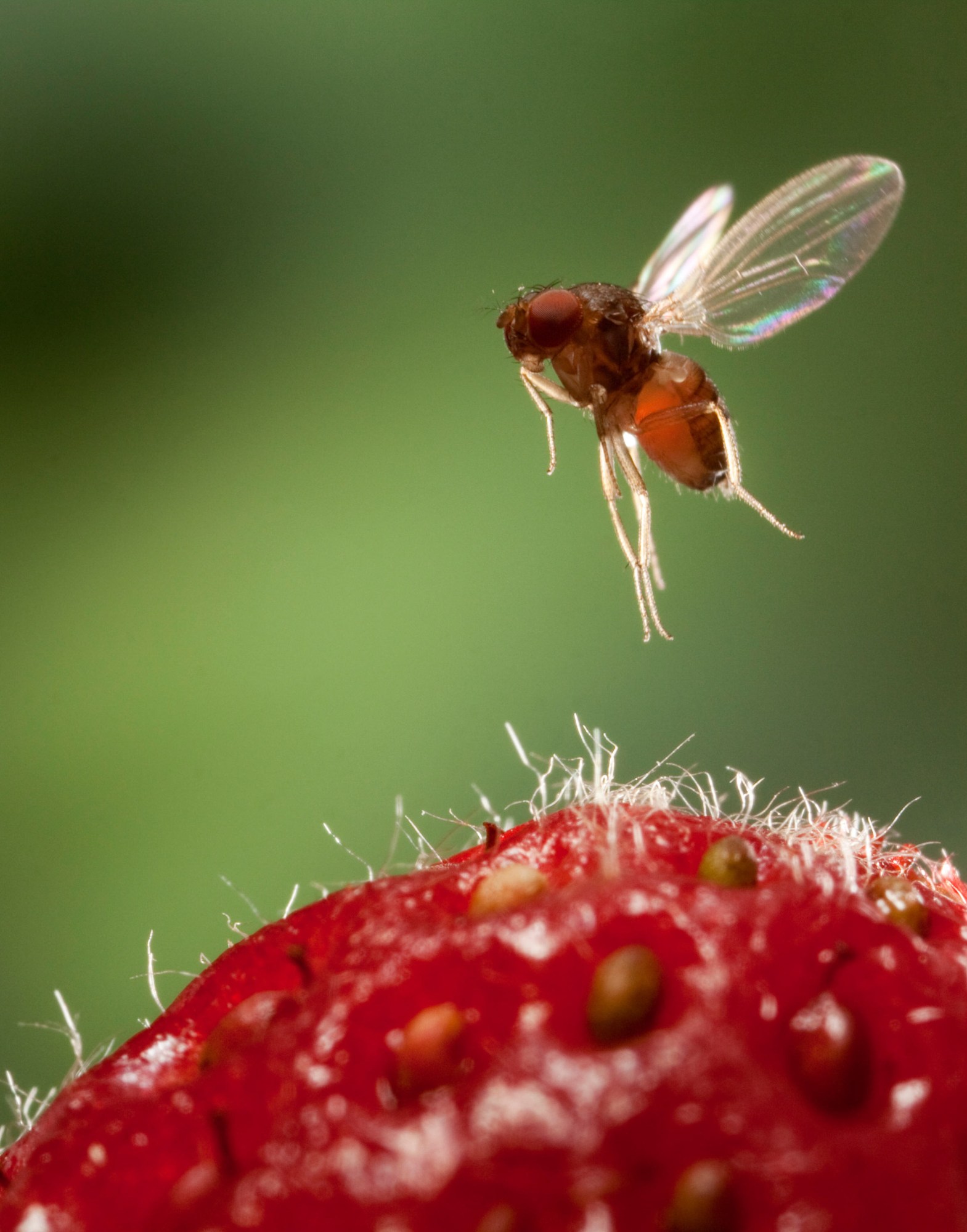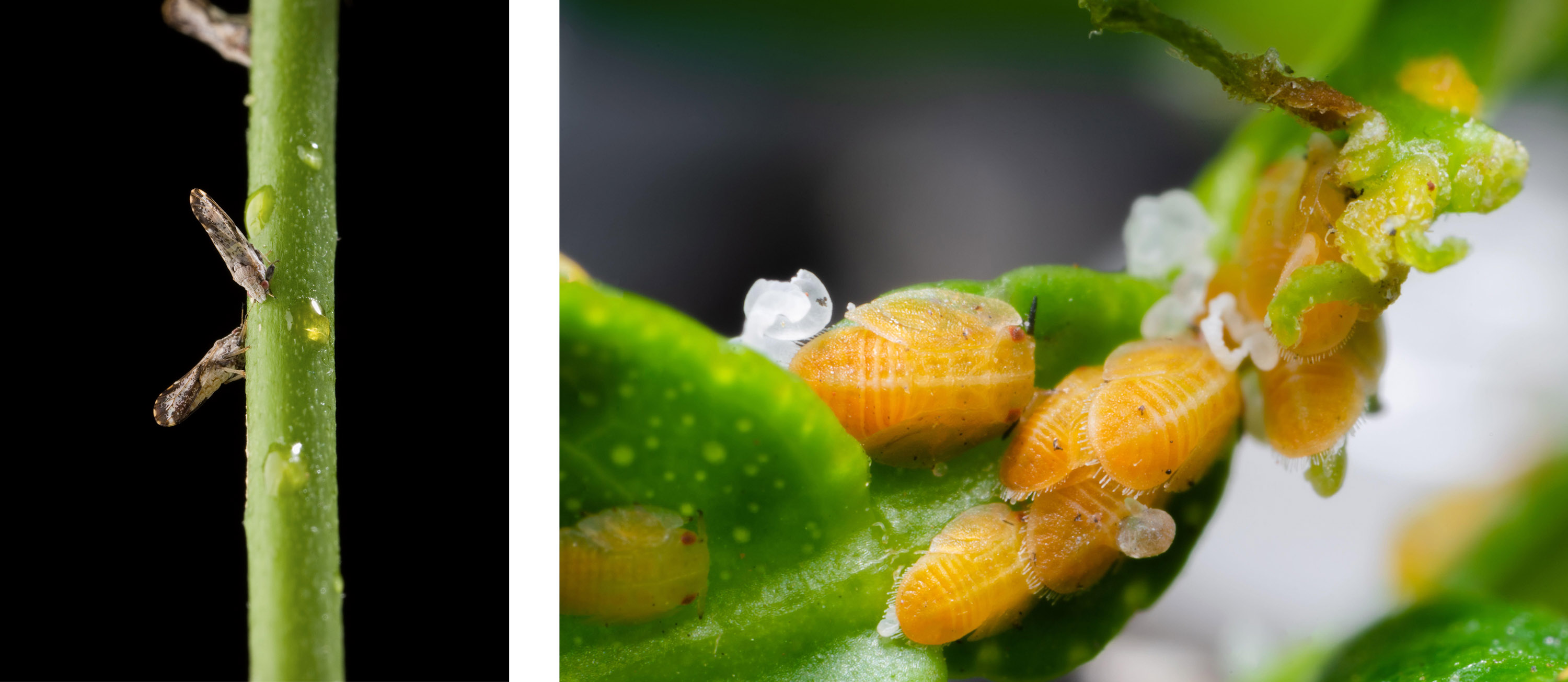How CRISPR could help save crops from devastation caused by pests
Gene editing insects could help reduce reliance on pesticides—and help protect billion-dollar industries.
Central California grape-grower Steve McIntyre was familiar with Pierce’s Disease. But that did not prepare him for what he saw when he visited his brother’s Southern California citrus and avocado farm in 1998. The disease, which causes vines to wither and grapes to deflate like old balloons, had long existed in California. But the infection he saw on a farm adjacent to his brother’s property seemed different.
“It was devastation,” says McIntyre. Blocks of grapes looked as though their irrigation had been entirely cut. On his flight home, McIntyre contemplated calling a realtor to offload his land. His own vines, he thought, were doomed.
Less than a decade after it was first identified in California, an invasive insect called the glassy-winged sharpshooter had turned the bacterium that causes Pierce’s from a nuisance to a nightmare. The oblong bug, with wings like red-tinged stained glass, is quicker and flies further afield than sharpshooters native to the state, and it can feed on tougher grapevines. Its arrival, which the state suspects was in the late ‘80s, supercharged the spread of the disease.

Through inspections and targeted pesticide spraying, the state has largely been able to confine the invasive sharpshooter to Southern California. But the disease still has no cure, and it’s at risk of getting worse and harder to combat due to climate change.
Researchers are now looking to add cutting-edge technology to California’s anti-Pierce’s arsenal, by changing the genome of the glassy-winged sharpshooter so that it can no longer spread the bacterium.
Such a solution is possible thanks to CRISPR gene-editing technology, which has made modifying the genes of any organism increasingly simple. The technique has been used in experiments in cancer immunotherapy, apple breeding, and—controversially—human embryos. Now a growing number of researchers are applying it to agricultural pests, aiming to control a range of insects that together destroy about 40% of global crop production each year. If successful, these efforts could reduce reliance on insecticides and provide an alternative to genetic modifications to crops.
For now, these gene-edited insects are shut away in labs across the globe, but that is poised to change. This year, a US company expects to start greenhouse tests in conjunction with the US Department of Agriculture (USDA) of fruit-damaging insects made sterile using CRISPR. At the same time, scientists at government and private institutions are beginning to learn more about pest genetics and to make edits in more species.
The use of gene-edited organisms remains controversial, and edited agricultural pests haven’t been approved for widespread release in the US yet. A potentially lengthy and still-evolving regulatory process awaits. But scientists say CRISPR has ushered in a critical moment for the use of gene edits in insects that impact agriculture, with more discoveries on the horizon.
“Until CRISPR, the technology simply wasn’t there,” says Peter Atkinson, an entomologist at the University of California, Riverside, who is working on modifying the sharpshooter. “We’re entering this new age where genetic control can be realistically contemplated.”
Know your enemy
Scientists didn’t know much about the genetics of the glassy-winged sharpshooter until recently. The first draft of its genome was mapped out in 2016, by a group at the USDA and Baylor College of Medicine, in Texas. But the map had gaps. In 2021, researchers at UC Riverside, including Atkinson, filled in many of them to produce a more complete version.
As scientists set out to gene edit more pest species, a better understanding of their biology and genetics will be important, says Linda Walling, a plant geneticist at UC Riverside who is working on the sharpshooter research. “There’s going to have to be a very big investment in understanding biology,” she says. “All we’ve previously wanted to do is just kill them.”
That understanding goes beyond DNA sequencing. Before making edits, researchers have to figure out what could stop an insect from harming a plant and then determine which edits could make that happen. In the case of the sharpshooter, there was a good candidate in hand: previous research from University of California, Berkeley, has shown that a carbohydrate in the sharpshooter’s mouth makes it easier for Pierce’s-causing bacteria to stick, and pointed to certain molecules scientists could modify to change that.

Now, a group at UC Riverside, including Atkinson and Walling, is trying to make those changes.
Part of the challenge is simply finding a way to deliver gene editing machinery to minuscule and fast-developing bug embryos.
“Delivery is the secret of everything,” says Wayne Hunter, a research entomologist with the USDA who worked on the 2016 draft of the sharpshooter genome.
Glassy-winged sharpshooter embryos are about 3 mm long. The Riverside team developed a novel way to inject them with CRISPR/Cas9 machinery without removing them from the leaf where they’re laid. The technique, according to a paper published last year, was “simple to perform, as a mass with 20 eggs can be injected within ten minutes by a novice operator.”
After injection, the team showed that CRISPR technology could cut and change the sharpshooter genome (as a proof of principle, the researchers used the technology to knock out genes that control sharpshooter eye color). Now, the group is working to insert genes in the sharpshooter’s genome that they hope will transform the tissue in the bug’s mouth so that it acts like Teflon, causing Pierce’s-causing bacteria to slide right off.
The team has received funding from the USDA as well as a board of wine industry representatives specifically convened by California’s government to combat Pierce’s.
The board, of which McIntyre is a member, supports a range of potential approaches to defeating the disease, including gene editing of grapevines as well as biopesticides, which are usually derived from natural materials. Pierce’s is a “uniquely terrible” problem for grape growers, says Kristin Lowe, the board’s research coordinator. “With most plant pathogens that are [spread] by an insect, you have to exploit any and all weaknesses you can find—in the biology, in the environment, in the ecology of that disease—to get long-term control.”
Operation fruit fly
Another California-hatched CRISPR technology has already begun the lengthy process toward commercialization for use in an agricultural pest.
Omar Akbari began using CRISPR as a postdoc in biological engineering at Caltech, soon after the release of a seminal paper on the technology. A decade later, his lab at the University of California, San Diego, uses CRISPR in nearly a dozen insect species.
One of its subjects is Drosophila suzukii, or spotted wing drosophila, a species of fruit fly that cuts holes in soft, ripe fruit like cherries and plums to lay its eggs. The flies, which spoil about $500 million in US fruit crops every year, have already grown resistant to some pesticides.
Akbari’s lab has used CRISPR to modify genes in order to create sterile males and kill females. Were those male flies to be released, they’d mingle with normal flies, and their inability to reproduce could depress the overall population.
Agragene, a company that licensed Akbari’s technology, has raised $5.2 million to commercialize this sterilization method in crop pests. The company is testing the product this year at greenhouses in Oregon.
The possible strategies for controlling pest populations and the diseases they transmit using CRISPR are numerous. “Your experiment is only limited by your ingenuity, to some degree,” says Nikolay Kandul, who works with Akbari at UC San Diego.
But researchers must also contend with biology, and the implications of their choices. For certain systems, like Akbari’s fruit fly edits, a change shouldn’t remain in the population unless gene-edited insects continue to be released. “It’s safe, it’s effective, it’s confinable, it’s not going to persist in the environment,” says Akbari.
Akbari has also worked on another approach that could be more permanent: gene drives. This technique cheats the rules of genetics, increasing an organism’s chance of inheriting certain genes and spreading them through the population. The technology’s potential has drawn excitement as well as concern (there are efforts underway to examine the use of gene drives in mosquitoes to disrupt malaria transmission, but many scientists have pointed out potential risks and urged caution).
“Chemicals can only travel so far before they degrade in the environment,” says Jason Delborne, a professor of science, policy, and society at North Carolina State University. “If you introduce a gene-edited organism that can move through the environment, you have the potential to change or transform environments across a huge spatial and temporal scale.”
Kandul puts it more bluntly. Gene drives, he says, can be “sloppy.”
Agragene considered deploying them in fruit flies, but Akbari says executives decided it would be difficult to attract investors and gain regulatory approval. Instead, the company went with the sterilization technology. After completing lab cage tests last year, Agragene is starting greenhouse tests in collaboration with the USDA, ones it hopes will ultimately pave the way for widespread release.
“You’re gathering enough data to show that your sterile insect is, in this case, safe,” says Agragene CEO Bryan Witherbee, who previously worked at Monsanto and other biotech companies.
The tests Agragene completed last year gave the company confidence that its sterile bugs could survive and function like nonedited bugs, says Witherbee, and the company also worked on techniques to manufacture sterile insects at scale. But Agragene is still determining what data it will need to submit to the US Environmental Protection Agency to get approval to release the bugs, a process that could take years.
In the US, the regulatory environment around CRISPR-modified insects is currently “evolving,” according to an EPA spokesperson. Government guidance released in 2017 outlined a coordinated approach that suggested the USDA will largely have authority over genetically engineered animals related to agriculture. But jurisdiction may vary depending on whether an edited organism is intended to reduce the population of an insect or disrupt disease transmission. Thus far, the US government has allowed the release of genetically modified mosquitoes, but tests of crop pests, like diamondback moths and pink bollworms, have been limited.
UC Riverside’s Walling and Atkinson expect that it will take years to refine genetically altered agricultural pests and get approval for their release. Agragene hopes the timeline could be faster: the company, which has already been in communication with the EPA, is targeting 2024 to submit an application for regulatory approval for commercial use of its fruit flies and expects the process to take up to two years.
Beyond editing
Gene editing insects may be a powerful tactic, but some experts in plant and insect biology see promise in other techniques as well.
For more than a decade, Hunter, the USDA entomologist, has worked on various efforts to map the genome of a pest that causes billions of dollars in damage across six continents each year: the Asian citrus psyllid, which spreads a disease that kills citrus trees, but not before leaving behind yellowed leaves and green, bitter fruit.
“You really don’t have much to sell even if the tree is alive,” he says.
He’s now part of a large, grant-funded team working on a variety of potential methods to protect trees from citrus greening disease. In the next few years, the group hopes to focus on several products or solutions that can then be commercialized for use in the field.

This year, Hunter will start using CRISPR to tweak genes that may neutralize the psyllid as a vector for spreading citrus greening disease. But he says plants modified to resist bacteria are still the most likely solution to deal with the disease. “That’s where the real answer is going to come from,” he says. Targeting insects could leave the disease circulating, albeit in a smaller number of bugs, but plant immunity would blunt the disease’s impact.
Still, modifying plants has its limitations as a general solution to the agricultural pest problem. Bugs like the spotted wing drosophila impact so many different fruits that producing resistant plant varieties would be exceedingly cumbersome, says Anthony Shelton, professor emeritus at Cornell University’s Department of Entomology who has worked on producing sterile diamondback moths.
When it comes to the age-old struggle between farmers and pests, Shelton says, it’s important to embrace a variety of new tools.
“I think we’ve all learned enough to know that there’s no silver bullet in agriculture or in medical entomology to try and control pests,” he says. “We’ve all become smarter, hopefully.”
Emma Foehringer Merchant is a journalist who often covers climate change, energy, and the environment. She is based in California.
Deep Dive
Biotechnology and health

This researcher wants to replace your brain, little by little
The US government just hired a researcher who thinks we can beat aging with fresh cloned bodies and brain updates.

Aging hits us in our 40s and 60s. But well-being doesn’t have to fall off a cliff.
Lifestyle changes could counter some of the deterioration.

Beyond gene-edited babies: the possible paths for tinkering with human evolution
CRISPR will get easier and easier to administer. What does that mean for the future of our species?

A new law in California protects consumers’ brain data. Some think it doesn’t go far enough.
Tech companies collect brain data that could be used to infer our thoughts—so it’s vital we get legal protections right.
Stay connected
Get the latest updates from
MIT Technology Review
Discover special offers, top stories, upcoming events, and more.